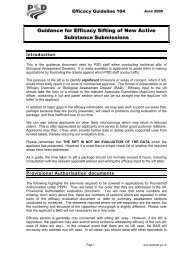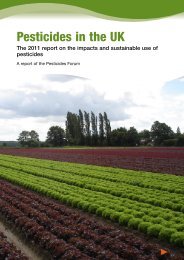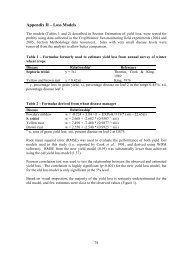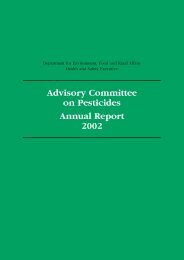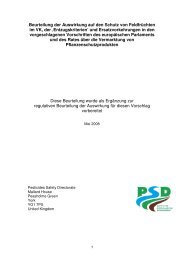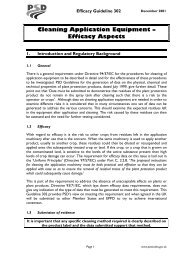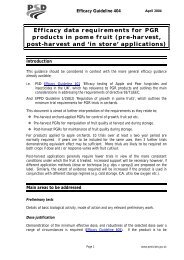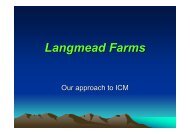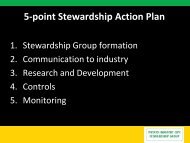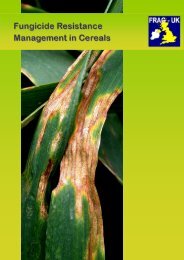Advisory Committee on Pesticides Annual Report 2001
ACP Annual Report 2001 - Pesticides Safety Directorate
ACP Annual Report 2001 - Pesticides Safety Directorate
You also want an ePaper? Increase the reach of your titles
YUMPU automatically turns print PDFs into web optimized ePapers that Google loves.
Secti<strong>on</strong> F: Other items c<strong>on</strong>sidered during the year<br />
Changes in the weight of registered disinfectants used were largely the result<br />
of an 86 percent reducti<strong>on</strong> in the use of sodium hypochlorite and a 75 percent<br />
reducti<strong>on</strong> in the use of formaldehyde.<br />
The use of the biological c<strong>on</strong>trol agent Steinernema feltiae had fallen by<br />
10 percent since the previous survey, being recorded <strong>on</strong> a total of 28 hectares<br />
of growing area.<br />
<strong>Report</strong> 172: Orchards and fruit stores in Great Britain 2000<br />
This report presented informati<strong>on</strong> c<strong>on</strong>cerning all aspects of pesticide usage<br />
<strong>on</strong> orchard crops in Great Britain during the 2000 fruiting seas<strong>on</strong>. Informati<strong>on</strong><br />
was obtained from visits to 256 holdings, which represented 33 percent of the<br />
total area of commercial orchards grown. Data were collected <strong>on</strong> the area of<br />
pesticide treatments and the amount of active substances applied and these<br />
had been extrapolated to give estimates of nati<strong>on</strong>al pesticide usage.<br />
There had been a c<strong>on</strong>tinual decrease in the area of orchard crops grown over<br />
the last nine years, with the present area being 21 percent less than that<br />
grown in 1992 and eight percent less than the last survey in 1996. With the<br />
excepti<strong>on</strong> of cider apples and perry pears, all crops surveyed showed<br />
reducti<strong>on</strong>s in the area grown since 1996, with a 29 percent drop in cherries,<br />
26 percent in other culinary apples, 23 percent in Cox’s apples and plums,<br />
21 percent in pears, five percent in Bramley apples, two percent in other<br />
top fruit (including nuts) and <strong>on</strong>e percent in other dessert apples. Only cider<br />
apples and perry pears showed an increase, the area grown being 23 percent<br />
more than in 1996, and 42 percent greater than in 1992.<br />
69<br />
Both the total spray area and the weight of pesticides applied had decreased<br />
c<strong>on</strong>siderably since 1992. This trend was reflected in every major pesticide<br />
group except for sulphur and growth regulators, with an overall reducti<strong>on</strong> in<br />
area treated of 16 percent since 1992. This trend had c<strong>on</strong>tinued between 1996<br />
and the current survey where overall pesticide usage had fallen by five<br />
percent, with <strong>on</strong>ly fungicides, sulphur and growth regulators increasing in use.<br />
The weight of active substances applied, had declined by 19 percent between<br />
1996 and 2000 and by 21 percent since 1992.<br />
With l<strong>on</strong>g-seas<strong>on</strong> perennial crops it is essential to protect growth throughout<br />
the growing seas<strong>on</strong> in order to ensure the producti<strong>on</strong> of high-quality fruit.<br />
This results in the majority of crops receiving some degree of treatment. For<br />
example in 2000, Cox’s dessert apple crops received <strong>on</strong> average, including<br />
repeat applicati<strong>on</strong>s, a total of 18 pesticide sprays, 35 products and 38 active<br />
substances. In c<strong>on</strong>trast, over 60 percent of other top fruit (incl. nuts); almost




